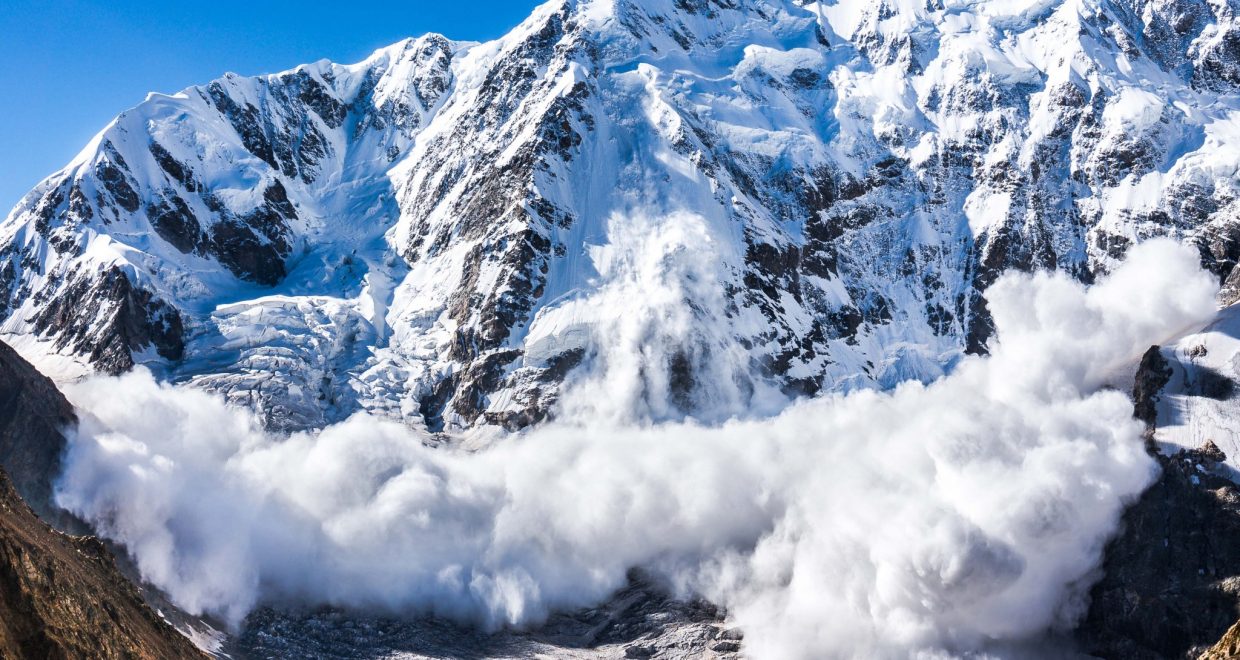Managing avalanche risk
Avalanches and mudslides are a common occurrence in mountainous regions across the world and they can often cause severe loss of property and life. A new experimental study in JFM sheds light on these events by providing a three-behaviour classification based on the conditions prior to the release of material. It is hoped that the model can be used to assist hazard assessment and risk mitigation in areas susceptible to these devastating flows.
Author Nico Gray and his team, consisting of researchers from the University of Manchester and the University of Liverpool, constructed an experimental setup in the lab that closely resembled the scenario seen in mountainous areas where material is released on top of an erodible base. Gray explains “the base layer was first prepared by a slow release of grains onto the inclined slope to create a static layer of uniform density”. The use of the erodible layer is essential in capturing the behaviour seen in real snow avalanches, where the hyper-mobility of such systems allows the avalanche to travel much further given the right slope conditions.
Once the base layer had been set, the slope angle could be increased further due to the hysteretic nature of the system. Hysteresis is a phenomenon in which a system behaves differently at a critical parameter value depending on whether the parameter of interest is increased or decreased through the critical value. In this instance, the angle of the slope is such that an avalanche of grains will occur once released before coming to a stop part way down the slope. However, the angle can then be increased further up to a second critical value before the grains will move once again.
Three distinct behaviours were seen in the experiments and in each case material was eroded at the front of the avalanche and deposited at the back. Typical across-avalanche profiles for the three behaviours are displayed in figures (a), (b) and (c). The profile shown is that remaining at the end of each experiment, with the flat areas at the edge giving the depth of the original base layer before the release of the avalanche.
For the case of a decaying avalanche there is a greater amount of deposition compared to erosion, which eventually causes the avalanche to ‘die out’. The trail left behind the avalanche is deeper than the surrounding material due to this increased deposition (a).
 For a growing avalanche the opposite is true; more material is eroded than is deposited which results in a trough being left behind by the flow (b). The trough also becomes wider as the flow progresses downstream.
For a growing avalanche the opposite is true; more material is eroded than is deposited which results in a trough being left behind by the flow (b). The trough also becomes wider as the flow progresses downstream.
 The third and final behaviour seen is that of a runaway avalanche. This is a particularly dangerous and destructive situation where the erosion and deposition of the material are in complete balance, thus creating a ‘runaway effect’. A shallow trough remains once the nose of the flow has passed, where the amount of material removed is equal to that deposited in the levees marking the path of the avalanche (c).
The third and final behaviour seen is that of a runaway avalanche. This is a particularly dangerous and destructive situation where the erosion and deposition of the material are in complete balance, thus creating a ‘runaway effect’. A shallow trough remains once the nose of the flow has passed, where the amount of material removed is equal to that deposited in the levees marking the path of the avalanche (c).
 A runaway avalanche is of great concern to hazard assessment in the run-out zones of avalanche-prone areas as they are theoretically able to propagate indefinitely. The erodible base of material is key to triggering this behaviour as it provides an apparently frictionless base upon which the flow can propagate. Were the base to be removed in the experiments, the avalanche would stop much sooner and therefore methods of increasing friction on slopes, such as increasing the amount of vegetation, provide possible solutions to managing the hazard risk.
A runaway avalanche is of great concern to hazard assessment in the run-out zones of avalanche-prone areas as they are theoretically able to propagate indefinitely. The erodible base of material is key to triggering this behaviour as it provides an apparently frictionless base upon which the flow can propagate. Were the base to be removed in the experiments, the avalanche would stop much sooner and therefore methods of increasing friction on slopes, such as increasing the amount of vegetation, provide possible solutions to managing the hazard risk.
In the real-world scenario all three behaviours will typically be displayed within a single avalanche due to the changing nature of the slope. Initially the slope is often steep which gives rise to a growing avalanche; the middle section sees a reduction in the slope and progression to a runaway or balanced avalanche; and finally the run-out zone is often quite flat resulting in a decaying avalanche. This is the next area of study that Gray and his colleagues have identified as they continue to produce ever more realistic simulations of an avalanche in the laboratory.
References:
Edwards, A., Viroulet, S., Kokelaar, B., & Gray, J. (2017). Formation of levees, troughs and elevated channels by avalanches on erodible slopes. Journal of Fluid Mechanics, 823, 278-315.






